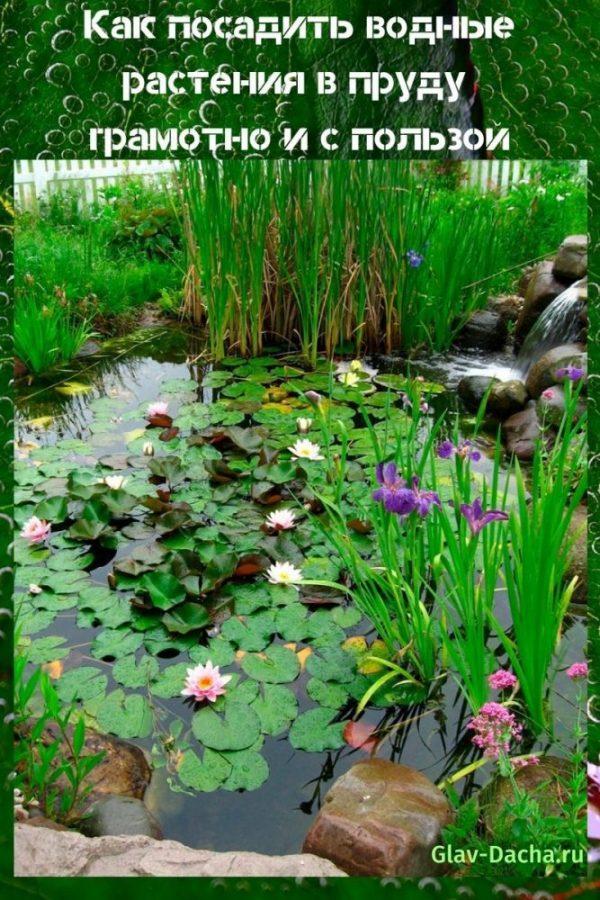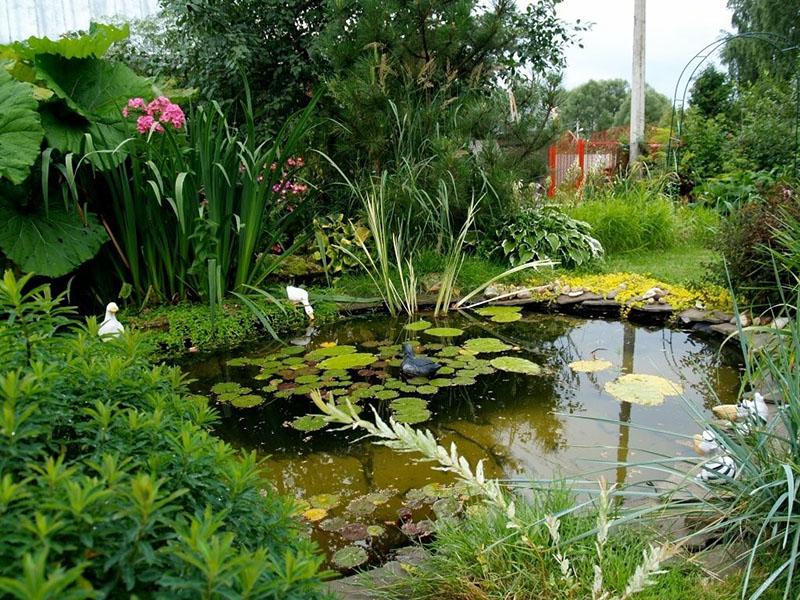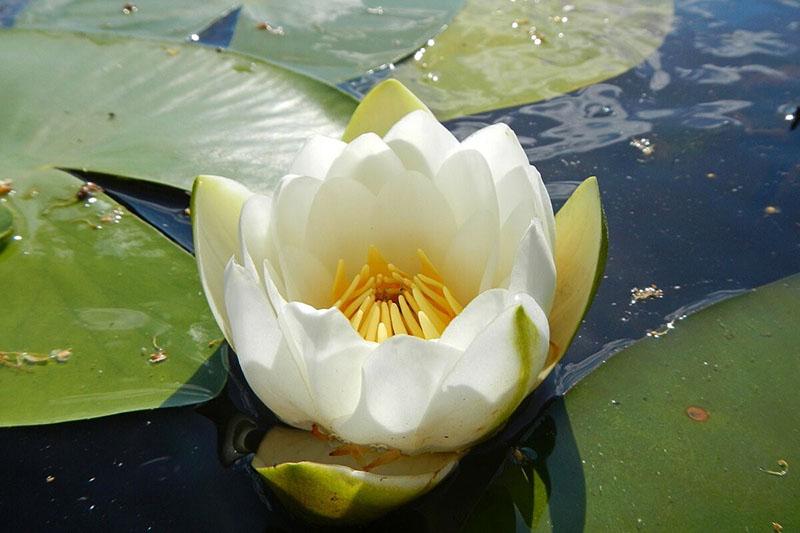How to plant aquatic plants in a pond wisely and profitably
 A self-created pond on the territory of a country house is truly a magnificent miracle. However, in order to preserve the ecosystem, it is important to know how to plant and care for aquatic plants in the pond. Lush greenery not only decorates the artificial lake against the backdrop of the country landscape. It serves as a unique cleanser and oxygenates it. Crops create a diffuse shadow over the surface of the water and absorb toxic gases. Besides, spending time with friends in such an oasis is a lot of pleasure. First, let's find out what plants can be planted in a pond so that they develop successfully?
A self-created pond on the territory of a country house is truly a magnificent miracle. However, in order to preserve the ecosystem, it is important to know how to plant and care for aquatic plants in the pond. Lush greenery not only decorates the artificial lake against the backdrop of the country landscape. It serves as a unique cleanser and oxygenates it. Crops create a diffuse shadow over the surface of the water and absorb toxic gases. Besides, spending time with friends in such an oasis is a lot of pleasure. First, let's find out what plants can be planted in a pond so that they develop successfully?
Decent choice is the key to success

Nymphea (water lily)
 The flower is considered the undisputed leader among its congeners. According to an ancient Greek legend, it symbolizes a beauty in love who has turned into a beautiful plant. Nymphaea is an aquatic perennial. It is equipped with a long dense stem and a developed root. The flower is kept on the surface with the help of root branches and wide foliage. Biologists count dozens of its varieties.
The flower is considered the undisputed leader among its congeners. According to an ancient Greek legend, it symbolizes a beauty in love who has turned into a beautiful plant. Nymphaea is an aquatic perennial. It is equipped with a long dense stem and a developed root. The flower is kept on the surface with the help of root branches and wide foliage. Biologists count dozens of its varieties.
Let's mark only the most popular:
- Victoria;

- Alba;

- Gold medal;

- Blue beauty;

- Rosea.

Depending on the variety, the water lilies differ in color. They come in almost every shade of the rainbow. Flowering occurs in mid-spring and lasts for several weeks.
The buds of the plant close at nightfall and go under the water, and in the morning they again decorate the surface of the pond.
Eichornia (water hyacinth)
 The attractiveness of the plant is given by exquisite inflorescences, consisting of many miniature buds. They are colored blue, pink and purple. Despite the fact that flowering lasts only a day, the decorative effect is preserved thanks to the glossy foliage of the porous structure.
The attractiveness of the plant is given by exquisite inflorescences, consisting of many miniature buds. They are colored blue, pink and purple. Despite the fact that flowering lasts only a day, the decorative effect is preserved thanks to the glossy foliage of the porous structure.
Hyacinth is an aquatic plant that purifies pond water, as its root system absorbs a number of harmful substances:
- phosphates;
- cadmium;
- insecticides;
- phenol.
The plant develops wonderfully at temperatures from + 14 ° C. It prefers soil containing sand and clay. The most popular varieties include:
- Variegated;

- Tolstonog;

- Azure.

Varieties of water hyacinth are distinguished by large inflorescences and decorative properties. The main condition for growing is the clean water that they create around them.
Egg capsule (yellow)
 The plant belongs to the genus of water lilies. It has large, deep green leaves and bright yellow buds.
The plant belongs to the genus of water lilies. It has large, deep green leaves and bright yellow buds.  During flowering, the entire territory is filled with a persistent, unique aroma. According to generally accepted rules for planting aquatic plants in a pond, the culture is placed at a maximum depth of 2 m.
During flowering, the entire territory is filled with a persistent, unique aroma. According to generally accepted rules for planting aquatic plants in a pond, the culture is placed at a maximum depth of 2 m.  It grows quickly, so it is only suitable for spacious artificial lakes.
It grows quickly, so it is only suitable for spacious artificial lakes.
Turcha marsh
 Water grass wonderfully takes root in fairly clean ponds. In the spring, she is under water for a long time. Only in the middle of summer it rises to the surface.
Water grass wonderfully takes root in fairly clean ponds. In the spring, she is under water for a long time. Only in the middle of summer it rises to the surface.  Luxurious inflorescences, consisting of many buds, turn an artificial lake into a "flower bed". Turchi marsh petals are painted pink or pale lilac.
Luxurious inflorescences, consisting of many buds, turn an artificial lake into a "flower bed". Turchi marsh petals are painted pink or pale lilac.
Pemphigus
 Although the plant belongs to the category of predators, it is actively grown in home waters. There are tiny bubbles on the surface of the leaf plates. They are a trap for small invertebrates.
Although the plant belongs to the category of predators, it is actively grown in home waters. There are tiny bubbles on the surface of the leaf plates. They are a trap for small invertebrates.  Pemphigus blooms for 3 months (all summer), which gives the pond a divine look.
Pemphigus blooms for 3 months (all summer), which gives the pond a divine look.
If fish are bred in an artificial lake, it is advisable to refrain from growing pemphigus. Otherwise, it will absorb animal feed.
Bog flower
 From the side, the leaves of the culture resemble a water lily in miniature. It is for this that the shield-leaved bog flower is valued. When its bright buds bloom, it seems as if bright lights are lit on the surface of the water.
From the side, the leaves of the culture resemble a water lily in miniature. It is for this that the shield-leaved bog flower is valued. When its bright buds bloom, it seems as if bright lights are lit on the surface of the water.
With their fragrance and beauty, the bog flowers fill the lake from June to August.
Peristle green
 The plant is often referred to as whorled urut. It multiplies rapidly and serves as a cozy refuge for fry of various fish species. Green cirrus is not afraid of low temperatures, therefore it perfectly tolerates winters. It refers to floating plants that thrive without soil. All vital substances are obtained by urut verticulata directly from the liquid medium.
The plant is often referred to as whorled urut. It multiplies rapidly and serves as a cozy refuge for fry of various fish species. Green cirrus is not afraid of low temperatures, therefore it perfectly tolerates winters. It refers to floating plants that thrive without soil. All vital substances are obtained by urut verticulata directly from the liquid medium.
Marsh calla
 The moisture-loving flower is a stylish decoration for artificial ponds. Its cordate foliage is located on long petioles. It has a slightly elongated shape and a shiny light green surface.
The moisture-loving flower is a stylish decoration for artificial ponds. Its cordate foliage is located on long petioles. It has a slightly elongated shape and a shiny light green surface.
During the flowering period, calla produces a fleshy peduncle, which is crowned with a pale yellow ear. It is reliably protected by a snow-white petal resembling a bedspread. Interestingly, the buds of the plant react to the approach of precipitation. The tip of the petal deviates noticeably from the tender cob, like the arrow of a barometer. At the beginning of autumn, instead of a bud, a scarlet fruit resembling a cherry is formed.
Although the calla emits a poisonous substance, its beauty gives the artificial lake a unique charm.
It is impossible to count all the options for aquatic crops that are grown in artificial reservoirs. However, there is no doubt that everyone will find the ideal option for themselves. Next, we will explore the process of growing such crops on our own.
How to plant aquatic plants in a pond
 Usually, green crops in natural lakes are arranged in 3 tiers: surface, underwater and free floating. This scheme is also carefully followed by specialists.
Usually, green crops in natural lakes are arranged in 3 tiers: surface, underwater and free floating. This scheme is also carefully followed by specialists.
At the same time, they take into account the main areas that relate directly to the pond:
- nearby territory;
- coastline;
- shallow part (plants are half submerged in water);
- deep-water section of the reservoir.
 First of all, the central zone is planted, which is distinguished by the greatest depth. Then they gradually move to the shore. Usually, planting in the pond begins in late spring or early summer. The main thing is that the water warms up well and takes on a transparent appearance. In addition, experts take into account the growth rate of crops. Indeed, in a limited space, each of them needs a sufficient amount of space, oxygen and valuable components for nutrition.
First of all, the central zone is planted, which is distinguished by the greatest depth. Then they gradually move to the shore. Usually, planting in the pond begins in late spring or early summer. The main thing is that the water warms up well and takes on a transparent appearance. In addition, experts take into account the growth rate of crops. Indeed, in a limited space, each of them needs a sufficient amount of space, oxygen and valuable components for nutrition.
Therefore, there is a simple scheme for choosing crops for a reservoir.:
- Coastal area. Usually placed 3 iris or 4 swamp forget-me-nots.
- Shallow water. Cattail, loosestrife and calla are suitable.
- Central deep part. Most often, a water lily of any kind is planted, a lotus and a capsule.
As a rule, seeds of aquatic plants for a pond are purchased at specialized retail outlets or online stores. Florists provide colorful catalogs of various types of crops that are suitable for the design of an artificial reservoir.
Landing technology
 In most cases, specialists grow aquatic plants in containers. An individual container is used for each culture.
In most cases, specialists grow aquatic plants in containers. An individual container is used for each culture.
Thanks to this, the plantings can:
- transplant;
- rearrange to different zones;
- clean up when cleaning the reservoir;
- "Preserve" for the winter (store in basements).
Before sowing aquatic vegetation of reservoirs, a substrate is prepared. Usually 2 parts of loose clay are mixed with peat or sand. The bottom of the container is covered with burlap, and soil is poured on top. After that, the seeds are spread.
To prevent the soil from leaching out of the container, cover it with a layer of gravel or pebbles.
 The planted crops are evenly distributed along the bottom of the reservoir. For example, tall species alternate with lush crops. In the deepest zone, various types of water lilies are planted, pinnate or kabombu - oxygenator plants for the pond. They generate huge amounts of oxygen and absorb harmful components in the water.
The planted crops are evenly distributed along the bottom of the reservoir. For example, tall species alternate with lush crops. In the deepest zone, various types of water lilies are planted, pinnate or kabombu - oxygenator plants for the pond. They generate huge amounts of oxygen and absorb harmful components in the water.
 Water hyacinth, salvinia and leafia are used as floating crops. Plants absorb nitrates from the reservoir and stop the reproduction of dangerous algae. Their greenery creates partial shade for fish during the summer heat.
Water hyacinth, salvinia and leafia are used as floating crops. Plants absorb nitrates from the reservoir and stop the reproduction of dangerous algae. Their greenery creates partial shade for fish during the summer heat.
Experts categorically prohibit planting duckweed in artificial reservoirs. It is difficult to get rid of it, and over time it will turn the lake into a swamp.
 Having figured out in detail how to plant aquatic plants in a pond, we can safely get down to business. Seeds of various types of crops are freely available in stores. And it is easy to choose a suitable option from the catalogs. It turns out that all ingenious is simple. The main thing is the mood and desire to work miracles.
Having figured out in detail how to plant aquatic plants in a pond, we can safely get down to business. Seeds of various types of crops are freely available in stores. And it is easy to choose a suitable option from the catalogs. It turns out that all ingenious is simple. The main thing is the mood and desire to work miracles.